Two formidable careers. Two unique creators. Ann Nocenti is aware she is the Lou Reed of Marvel Comics. I could go on at length about her carving out space in mainstream comics for more nuanced characters, or how confronting the military-industrial complex in the floppies was a precursor to journalism and filmmaking. She’s an inspiration. As is illustrator David Aja. His work on the Pizza Dog Hawkeye run opened the eyes of a new generation of artists to comics’ visual potential, just as Nocenti did for character development. Legends, the both of them.
The Seeds is a new project from Nocenti and Aja, an enigmatic miniseries collected late last year as a graphic novel by Karen Berger’s Berger Books, an imprint of Dark Horse Comics. Here’s what Dark Horse has to say about the “eco-fiction tech thriller-meets-love-story” in the book’s press junket:
The bees are swarming. What do they know that we don’t? In a broken-down world, a rebellious group of ruthless romantics have fled a tech-obsessed society to create their own& and a few cantankerous aliens have come to harvest the last seeds of humanity. When one of them falls in love with a human, idealistic journalist Astra stumbles into the story of a lifetime, only to realize that if she reports it, she’ll destroy the last hope of a dying planet. How far will she go for the truth?
I found The Seeds challenging and compelling. A serious book about journalism and truth where an intergalactic conspiracy is real and, even juicier headline, the source of forbidden love. It takes poetry to speak truly of resilience, and The Seeds does, connecting the dots between visual echoes and plot synchronicity until the labyrinth the story resides within also ensnares the reader.
The Beat spoke with Nocenti and Aja about new experiences and longtime admiration, looking for good where vintage and modern overlap, and telling stories with representation rather than about it. Nocenti can call it back from my riffing on a theme to specific scenes in the story, and Aja responds in philosophical poetry about the weight of moments that occur outside the narrative of your life.
Arpad Okay: Both of you have influential careers in comics, over many years and many more creator credits. Can you to tell me about the things that you brought to The Seeds that were new for you? Where were you challenging yourself, experimenting, reaching outside of your comfort zone?
Ann Nocenti: Most of my previous comic work was writing super-heroes. An existing icon, such as Batman or Spider-Man, in a way, has your back. They walk into a room with the gravitas of decades of great stories. The super-hero narrative, with its escalation to an action climax and fight, is a buttress you can hang a story on. From that supportive place, of telling an action tale about an iconic character, a writer can just riff away. With The Seeds it was more like jumping off a cliff. Being in freefall. Turning your mind inside-out and letting the world see inside, and hoping they won’t think you nuts. I was able to take my personal obsessions and weave them into the narrative in ways I’ve never been able to do before. I’ve done environmental and media stories before, but they were secondary to the action narrative. In The Seeds, they are the narrative. Of course, David Aja is a master, so simple ideas like a farmer’s relationship with his pig he’s about to kill, drawn by David, become transcendent.
David Aja: I think almost everything [was new]. I like to approach each new project in a different way so I suppose somehow, I’m challenging myself all the time. Why? On one hand I do not like to repeat what I have done, because I have already done it. And on the other hand, I think each story needs its own way to be told, and in this particular case with The Seeds I made a lot of decisions that probably complicated my life: A very rigid panel structure, chapters structure, repetition of abstract and organic motifs and patterns, more use of the light when drawing than the line, playing with just two colors… and on and on. Yes, I like to complicate things for myself, hah, but I hope it has been good for the story.
Okay: What was it like working with Karen Berger and Berger Books? The Seeds is a relatively intimate project with just the two of you handling writing, art, lettering. How did Berger’s involvement impact your collaboration?
Nocenti: There would be no Seeds without Karen Berger. David Aja and I tossed a lot of ideas back and forth, and managed to develop a story, but we never would have made the comic without Karen. Karen has a brilliant way of nurturing the good ideas and tossing the bad ones. She has a natural literary style – she never pushes for the standard narrative tropes of stories, rather she wants to go deeper, help you find your voice. In a similar way, with Ruby Falls, she encouraged Flavia Biondi and I to tell a personal story about three generations of women. It’s hard to explain, because good editors are intuitive, but with Karen we always knew we were in good hands. And because she nurtured so many new voices with her Vertigo line over the years, I never wanted to let her down. So when Karen cracked the whip, sending me great notes on scripts, asking me to make them better, it was easy to dive back into re-writes.
Aja: Well, for me, working with both Karen and Ann has been a dream. When Ann and I were beginning our project, I remember I was obsessed with the idea of Karen editing it, I wanted it to be her, actually I wanted her to be my editor since I was a kid, hah. And she gets it. And it has been even better than I thought, this is her book too, I would have not been able to do it all without her support and understanding. Basically, there would not be The Seeds without Karen, she has been there the whole time, she’s part of the team.
Okay: Your book is a story about publishing, told in a monochrome offset print, with textured cover and French flaps. Within, there’s a wall between technology and luddites. It’s tempting to polarize new and old in real life. But neither technology nor the natural world are going away, and The Seeds is a story of cohabitation. Talk to me about some ways analog and digital have come together that you think works.
Nocenti: The initial idea of the wall between zones came from what I imagine to be a universal feeling. We all have love/hate relationships with our tech, our phones, our computers. Our tech has become our back-up brain, the fluid we swim in for social interaction. Being raised pre-internet, I miss getting lost in the world, untethered by a phone. So I guess I’d like to live in a world where we could access tech without it becoming a psychological crutch. The tech-free zone in The Seeds is for those that need to go cold turkey – kick the habit. Lola’s nature changes radically once she’s in the tech-free zone. She loses her germaphobia, her fingers stop twitching. As for analog and digital, David and I talked about how we wanted to embrace it all in The Seeds. We wanted to telescope time, so that there is futuristic tech layered with archaic tech.
Aja: Hurmm, obviously technology is useful. The Seeds was made thanks to technology. I mean, Ann and I created it through emails, it is drawn digitally in PS with a Cintiq, more emails and Skype with Karen, all production to print is also digital… But it’s true that I thought a lot about the printed piece, in the book as an object. We were choosing papers, pantones and designing it all to be a nice piece (that also smells great, by the way, like a crayons box). So here you have an example where digital goes to analog and works (and smells) great, hah. See? Even here our book is a perfect metaphor, a beauty allegory. Can you see poetry all around it, Arpad? What have we done? What a masterpiece we have created? Eh… what was the question?
Okay: I can’t help but notice the investigative reporter who shakes the pillars of the earth lives somewhere between poverty and squalor. In the afterword, Ann presses the importance of supporting independent comic imprints. Do you two think there’s a relationship between pushing the envelope and being a cult classic instead of a blockbuster?
Nocenti: I’m paraphrasing here, but someone from the band The Velvet Underground once said something like “We never sold many records but everyone who bought one started a band.” So yes, nothing in my career, be it my journalism, comics or film, has ever been a blockbuster, but hopefully the few who have embraced my work were inspired to make something of their own. I do hope that The Seeds is stealthy, and sparks ideas in others. The Seeds presents questions with no clear answers, so I do hope readers answer those questions for themselves. The Seeds is an invitation to interpret – no “reading” of The Seeds, in terms of what it all means, is incorrect. The story is somewhat mysterious and cryptic to invite reader engagement.
Aja: I’m fine being a cult classic as long as we sell as much as a blockbuster.
Okay: Lola, a central character in the book, is someone who uses a wheelchair. There’s a gulf in comics where ability diversity should be, and Lola’s experience is nuanced, authentic in its understatement. Can you talk to me a little about what you wanted from this element of the story?
Aja: Lola represents just a girl. Yeah, she had a wheelchair and Astra wore glasses. They both use something that helps them with their disabilities. Does Astra represent people with glasses? I mean, we should show wheelchairs and disabilities because we all live with them, and I really hope someday a wheelchair will be seen as normal in media as glasses are.
Okay: The black bars over the eyes at the aliens anonymous meeting is one of the book’s better head checks — mostly it feels as if we experience The Seeds sharing its characters perspective, passing time panel by panel. The story feels conscious of having an audience. When you were telling The Seeds, who did you picture yourself telling it to?
Nocenti: David surprised me with the black bars over the eyes, and I was delighted. It wasn’t in the script. I never asked him what it meant, so only he knows. For that scene, I had read interviews with people that felt they had met aliens, or been abducted by aliens. I wanted to respect their POV, so that scene is from the abductees POV, in that it gives them voice.
Who did I picture telling The Seeds story too? I guess at first I was talking to myself and David. I had questions I couldn’t answer. What is clocking so much time online doing to us, to our future? Where were the bees going? Why do we eat our fellow creatures? If we use tech to fix the things we broke in nature, what will be lost? Why is the world so divided? Have we become aliens to each other? So I guess I was asking these questions to myself, and tossing them at David, and then he wove his questions and answers and obsessions into the narrative, and together we tossed these seeds out into the world, hoping to spark thought.
Aja: Well, they were anonymous. I suppose the first one I was telling the story was to myself. I know how this sounds, hah, but really, I have to love what I’m doing, and I hope that as I have such a refined taste, if I like it, everybody will as well.
Okay: If one wanted to continue the discussion you’ve started with The Seeds, what are some books, films, art, media of any kind, that keep it going? Other works that you feel compliment the ideas you present in yours; spiritual sister stories.
Nocenti: I love fiction films that feel like documentaries. The Seeds is grounded in a documentary sensibility, I hope. So maybe some of the natural-yet-rarified meandering you’ll find in films like Michelangelo Antonioni’s The Passenger, or Terrence Malick’s Badlands, Nicholas Roeg’s Walkabout…. Or Haskell Wexler’s Medium Cool, films that are fiction/doc hybrids. Films like that are touchstones for me.
Aja: I was about to write a bunch of comics, movies and books, that, even not being too close, as I think we drop lot of different ideas, maybe you could find bits here and there or stuff that influenced us… Buuuut, nope. Open your window or your door instead. See people? Nah, look closer. Do you see all that life, intelligent life, around? Look at the birds. There is a robin that use to prowl around my place. Last week there was a snowfall here, and since then, he came to me every time I go out because he knows I’m going to drop some bread. I have a magpie that recognizes me and knows how to ask for water or food. Look at your dog that knows when you are down, look at your cat that… well, does cat things. Just look around, at how the trees are passing the winter, take care of that plant in your studio… and then, if you want, came back to the usual hate and shit around, but at least, maybe, you have taken a break to see another point of view in the real life that is also around us. And maybe that’s what a comic can be after all.
Okay: And what are you working on next? What are some of your friends’ things you’re excited about? What are you looking forward to, what are you dreading?
Nocenti: Right now, I’m drawing a bit, trying to find my next story though scribbles. I buy comics by exploring comic shops, and at conventions by wandering the artist’s alley, looking especially at indies, and self-published small print runs… so I’m looking forward to that feeling of discovery when things open up again. The most recent comic I read and loved was I.D. by Emma Rios. Also, I got a sneak-peak at David’s Batman Black & White story coming out soon, and besides being gorgeous, the story is a cool and provocative take on Batman.
The Seeds is available now from Berger Books and Dark Horse Comics.



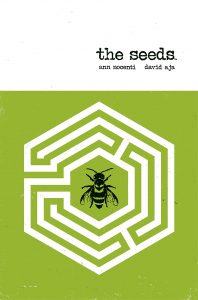
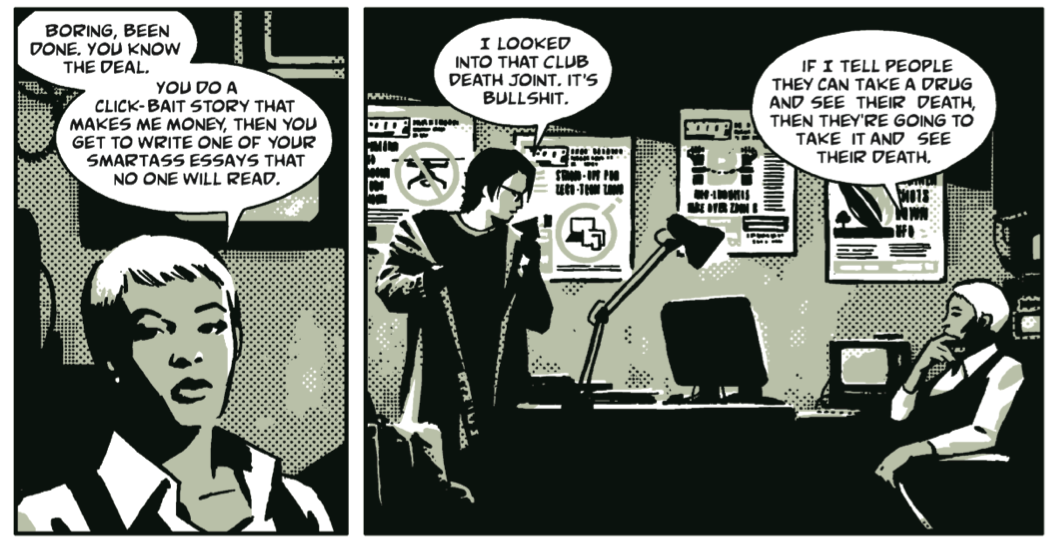
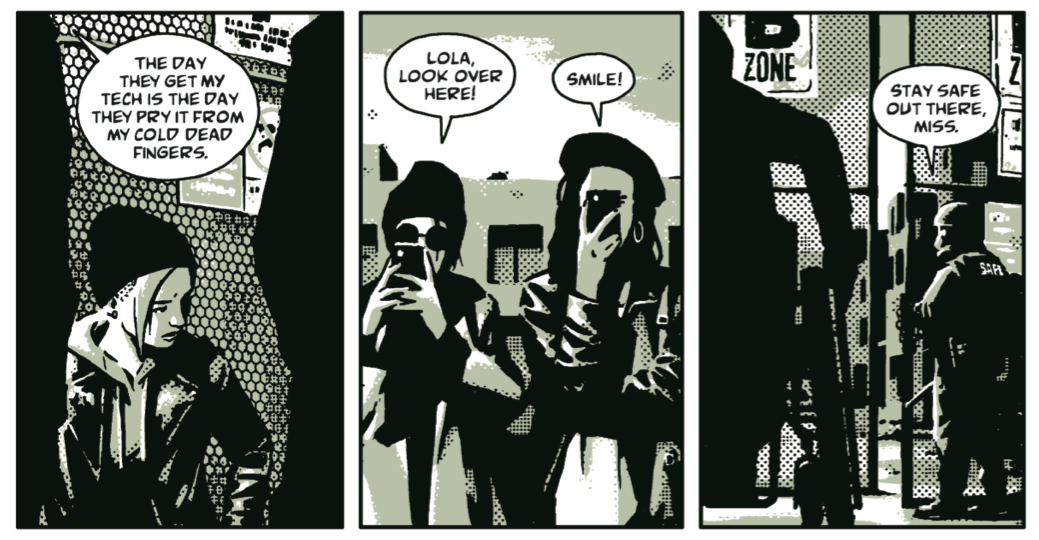
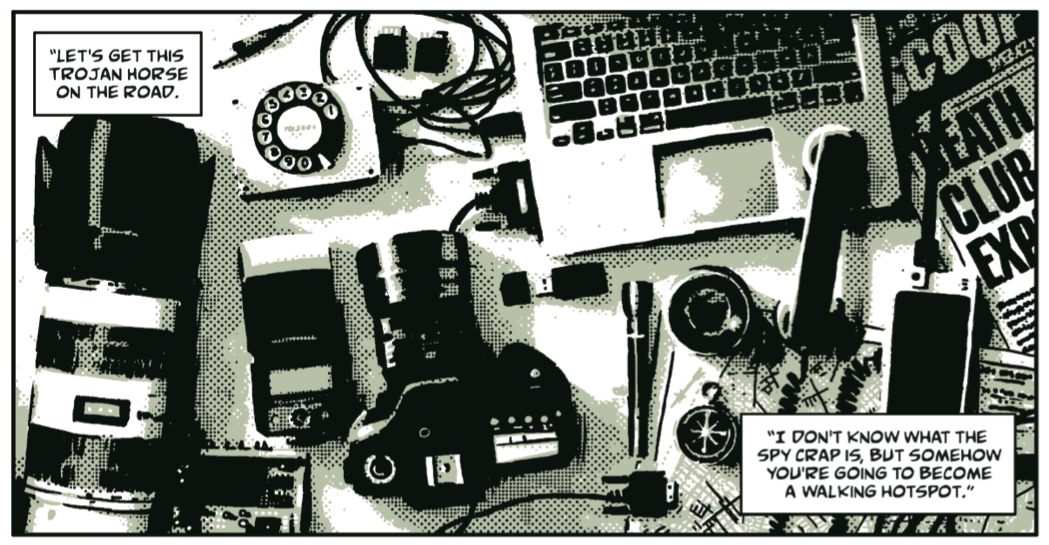
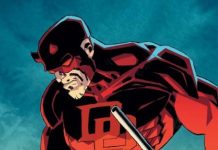




great interview. thanks!
Comments are closed.